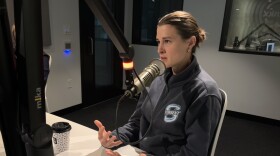Mike Trostel is the senior historian and curator at the U.S. Golf Association museum in Far Hills, N.J., and is among the thousands of people in the Puget Sound this week for the U.S. Open.
We sat down with him to talk about the history of the U.S. Open, and about golf's future. Our conversation took us from the first U.S. Open in Rhode Island, to the moon, and back.
Here are five things we learned from Trostel:
1. It took a long time for golf's premiere event to head west.
The first time the U.S. Open came to the west coast was in 1948 – in Los Angeles – more than 50 years after the event began. This is the event’s first time in the Pacific Northwest.
“The closest we’ve come to the Pacific Northwest before was San Francisco. We played at the Olympic Club,” Trostel said. “It’s a championship that belongs to the whole country, so we knew we needed to come to the Northwest.”
2. One of this year's players isn't old enough to drive a car.
“The great thing about the U.S. Open is the democratic nature of it. Anyone who has the skill and the passion can go out and win this championship,” Trostel said.
This year’s field includes past U.S. Open champions, but also a 15-year-old amateur. Nearly 10,000 people tried to get into the field of 156 that will take the course this week in University Place. By Friday, the field will be down to 60.
When the U.S. Open began in 1895, there were 11 entries.
3. The U.S. Open trophy was destroyed in a fire.
The sterling silver trophy has been hoisted aloft by golf’s biggest names. And it carries the name of every winner in the history of the U.S. Open. But it’s not the one originally made for the first event.
“Lloyd Mangrum won in 1946. (His home club was) called Tam O’Shanter, outside Chicago. He put it on display there, and the clubhouse burned down,” Trostel said. “Thankfully we had the specs, and were able to recreate one that looks exactly the same.”
4. The star of this year's Open is likely to be the course itself.
Sometimes a player emerges as the main attraction at a U.S. Open. But the Chambers Bay golf course itself – a links style course, with tall roughs and rolling slopes – is likely to be the star of this show.
“It’s a tough walk,” Trostel said. “I’ve walked the course and it’s not easy. But the mental factors and the strategy that goes into it – it’s a little bit of raw athleticism, but it’s also some strategy. There’s some chess involved, if you will. You’re playing against mother nature. It could be windy, it could be rainy, or it could be 85 degrees, too. You don’t know what you’re going to get.”
5. No one knows what kind of golf balls were hit on the moon.
Astronaut Alan Shepard famously hit some golf shots on the surface of the moon, during the Apollo 14 mission in February 1971.
https://www.youtube.com/watch?v=f-FxhCZold0
The club was a Wilson 6-iron head attached to an instrument used for collecting lunar rock samples. But no one knows what kind of golf balls he hit.
“Shepard whent to his grave not telling anyone what brand of golf ball it was,” Trostel said. “He didn’t want any single brand to benefit from it.”
Maybe someday we’ll go up and get them back.








